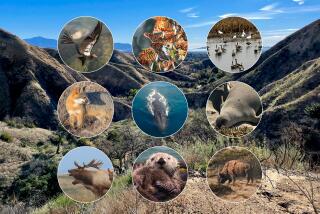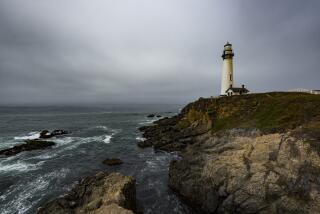Where Nature in the Wild is Top Attraction
SEWARD, Alaska — Capt. Pam Oldow has watched visitors wipe tears from their eyes in this theater of nature called Kenai Fjords National Park.
“Tears of joy--tears for the wonderful things that God created,” Oldow says.
Kenai Fjords, a 580,000-acre wonderland of glaciers, snowy peaks, whales and sea birds, is one of Alaska’s least-known treasures. Alaska’s “mainline” national parks--such as Denali (featuring Mt. McKinley) and Glacier Bay--are the high-volume destinations for tour operators. Kenai Fjords is mostly for those travelers who prefer to go exploring on their own.
The park begins on the outskirts of Seward (Pop. 2,200), a pretty port and railroad town 130 miles south of Anchorage, and stretches south about 410 miles along the western edge of the Kenai Peninsula.
Driving time from Anchorage on the Seward Highway is about three hours. The Alaska Railroad has daily service between Anchorage and Seward from late May to early September.
The only way into the scenic heart of Kenai Fjords for most visitors is to book day-cruises aboard tour vessels based in Seward’s small-boat harbor. Two operators--Kenai Fjords Tours and Kenai Coastal Tours--offer either full-day or half-day cruises.
Otherwise, the park’s wonders are reserved for experienced hikers on ice-field treks or saltwater kayakers who can handle sudden storms. The wilderness park’s array of marine life is impressive: humpback whales, gray whales, killer whales, Steller’s sea lions, sea otters, Dall porpoises, harbor seals and more.
In addition, the park is home to more than 100 species of bird, from bald eagles to clown-faced puffins. Some estimates place the puffin population at 20,000.
Tour boat passengers can get within snowball-throwing distance of giant glaciers that sweep down mountain valleys to the sea like rivers of ice.
Fortunately, evidence of the disastrous Exxon Valdez oil spill is far away and out of sight. Only a few tendrils of crude drifted here from the spill site, about 150 miles to the northeast in Prince William Sound, and damage to wildlife was minor.
“We still see all the animals, all the great things we’ve always seen,” Oldow said.
The scenes come swiftly, dramatically here: playful sea otters floating on their back in jade waters; thousands of puffins and kittiwakes whirling against the sky; colonies of sea lions basking on secluded islands like lazy vacationers; a ballet of porpoises flashing by tour boats like welcoming committees; bald eagles soaring on the wind currents, and, of course, the towering, blue-white glaciers.
Off Cape Aialik, a pod of at least 10 killer whales--dorsal fins slicing through the water like black blades--surround tour boats like a nervous posse. The whales are so close that passengers can hear the tuba blasts of their breathing.
A sightseeing vessel turns toward the Chiswell Islands, where dozens of glossy-brown sea lions are loafing on rocky platforms. Naturalists estimate the park’s count of sea lions at about 4,000.
It is a fine summer day, time for the big bull sea lions to gather their harems for breeding. The males are barking and snorting. With a surge of surf, a big bachelor bull hauls itself from the sea and attempts to reach a cluster of females resting on a nearby ledge.
The harem is being guarded by a surly bull, scarred from many battles. The intruder slips on mats of wet kelp draped over the cliff and slides back into the sea.
Overhead, thousands of sea birds--tufted puffins, horned puffins, black-legged kittiwakes, common murres and gulls--are wheeling and swooping by their island rookeries. The sky is so filled with birds that at times they almost blot out the sun.
“And this is nothing unusual,” Oldow proclaimed.
All eyes--and cameras--are on one plump puffin, so overloaded with a seafood lunch that it is unable to lift off the water. Wings beating, the bird bangs down the briny runway like a crippled airliner, then aborts the takeoff.
But Kenai Fjords is more than wildlife. It also is a showcase for some of nature’s most violent forces.
Moist air billows off the Gulf of Alaska and restocks the park’s 300-square-mile Harding Icefield with 35 to 65 feet of snow each year. Then the snow is pressed and shaped over time into glaciers that flow down from the ice field like giant bulldozers.
Meanwhile, the seaward ends of the Kenai Mountains are slipping into the sea, being dragged under by tectonic collisions far below the waves. Alpine valleys that once cradled glaciers thus become deep-water fiords in a few ticks of geological time.
One of the national park’s great attractions is Holgate Glacier, a massive wall of ice that towers hundreds of feet over the sightseeing boats. Its tidewater-washed face is a savage mass of icy swords and crevices glowing with blue-white fire.
Tour vessels approach cautiously, dodging stray bergs hurled into Holgate Arm by the glacier’s constant “calving.”
We are lucky today. There are sharp reports, like rifle fire, as ice across Holgate’s snout cracks from incredible pressures deep inside the glacier. Then, with a thunderous roll, mighty slabs of ice fall into the sea.
But the show isn’t over yet. High above, on a vertical cliff, a frisky young mountain goat dashes across the rocks in a perilous traverse. The kid slips and begins what looks to be a fatal tumble. Passengers gasp.
In the blink of an eye, the mother goat moves down slope and breaks the fall. It was as if the nanny had anticipated the youngster’s foolish fun.
More to Read
Sign up for The Wild
We’ll help you find the best places to hike, bike and run, as well as the perfect silent spots for meditation and yoga.
You may occasionally receive promotional content from the Los Angeles Times.






